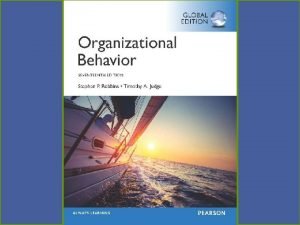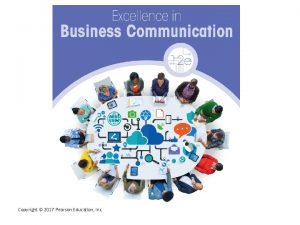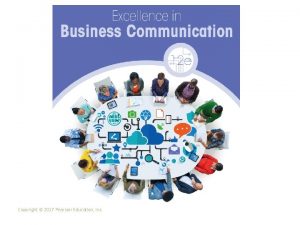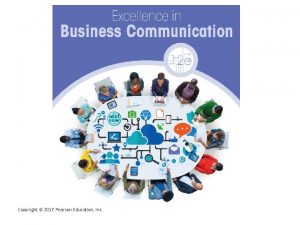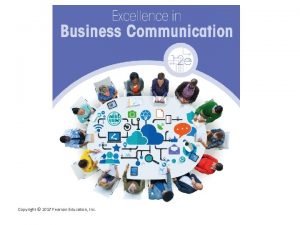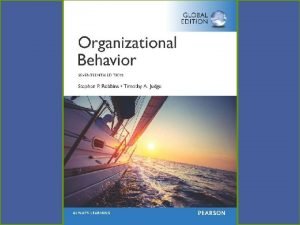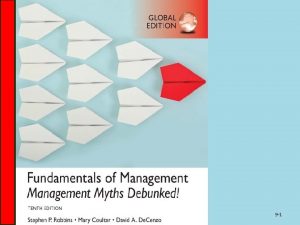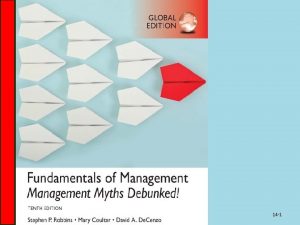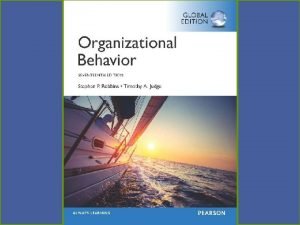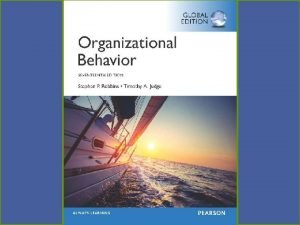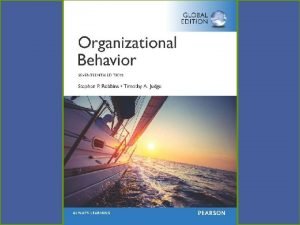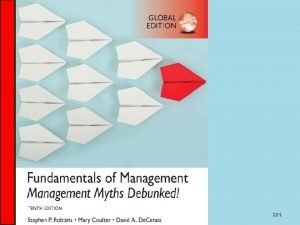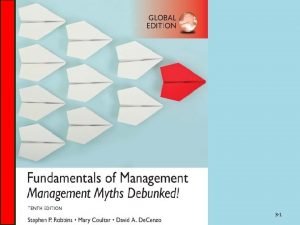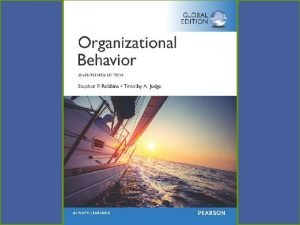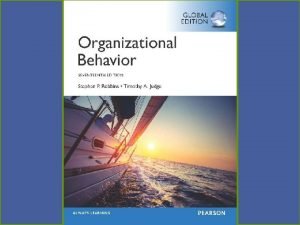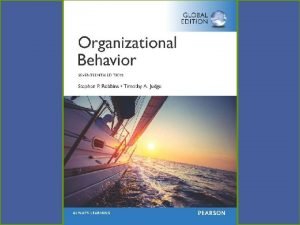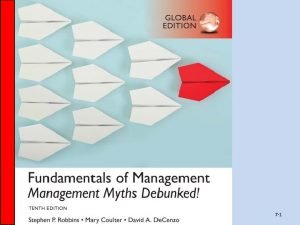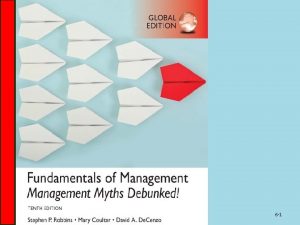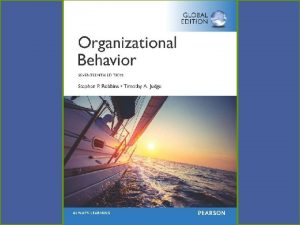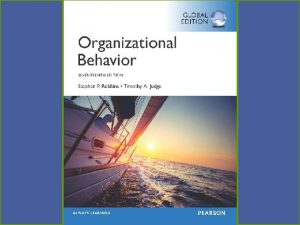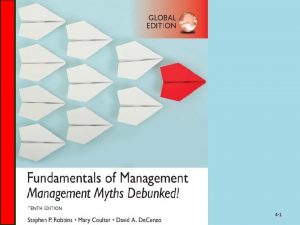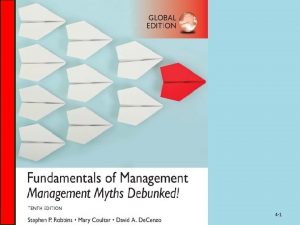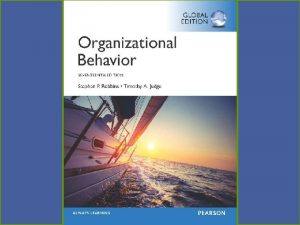Copyright 2017 Pearson Education Ltd 11 1 11





























- Slides: 29

Copyright © 2017 Pearson Education, Ltd. 11 -1

11 Motivating and Rewarding Employees Copyright © 2017 Pearson Education, Ltd. 11 -2

Learning Outcomes q Define and explain motivation. q Compare and contrast early theories of motivation. q Compare and contrast contemporary theories of motivation. q Discuss current issues in motivating employees. Copyright © 2017 Pearson Education, Ltd. 11 -3

11 -1 Define and explain motivation. Copyright © 2017 Pearson Education, Ltd. 11 -4

What is Motivation? • Energy • Direction • Persistence Copyright © 2017 Pearson Education, Ltd. 11 -5

11 -2 Compare and contrast early theories of motivation. Copyright © 2017 Pearson Education, Ltd. 11 -6

Maslow’s Hierarchy of Needs Copyright © 2017 Pearson Education, Ltd. 11 -7

Mc. Gregor’s Theory X and Theory Y n n Theory X Little ambition Dislike work Avoid responsibility Must be closely controlled Theory Y n Enjoy work n Seek and accept responsibility n Exercise self-direction Copyright © 2017 Pearson Education, Ltd. 11 -8

Herzberg’s Two-Factor Theory Copyright © 2017 Pearson Education, Ltd. 11 -9

Satisfaction vs. Dissatisfaction Copyright © 2017 Pearson Education, Ltd. 11 -10

Mc. Clelland’s Three-Needs Theory Three acquired needs are work motives: 1. Need for achievement 2. Need for power 3. Need for affiliation Copyright © 2017 Pearson Education, Ltd. 11 -11

11 -3 Compare and contrast contemporary theories of motivation. Copyright © 2017 Pearson Education, Ltd. 11 -12

Goal-Setting Theory Copyright © 2017 Pearson Education, Ltd. 11 -13

Influences on Job Performance • • Feedback Goal commitment Adequate self-efficacy National culture Copyright © 2017 Pearson Education, Ltd. 11 -14

Job Characteristics Model Copyright © 2017 Pearson Education, Ltd. 11 -15

Job Design and Motivation Internal rewards are obtained when an employee learns that he or she personally has performed well on a task he or she cares about. Copyright © 2017 Pearson Education, Ltd. 11 -16

Guidelines for Job Redesign Copyright © 2017 Pearson Education, Ltd. 11 -17

Equity Theory Copyright © 2017 Pearson Education, Ltd. 11 -18

Expectancy Theory Source: V. H. Vroom, 1966 Copyright © 2017 Pearson Education, Ltd. 11 -19

Integrating Motivation Theories Copyright © 2017 Pearson Education, Ltd. 11 -20

A Closer Look at the Model Copyright © 2017 Pearson Education, Ltd. 11 -21

11 -4 Discuss current issues in motivating employees. Copyright © 2017 Pearson Education, Ltd. 11 -22

Current Issues Copyright © 2017 Pearson Education, Ltd. 11 -23

Country Culture and Motivation Managers can’t assume that motivational programs that work in one geographic location are going to work in others. Copyright © 2017 Pearson Education, Ltd. 11 -24

Cross-Cultural Differences Copyright © 2017 Pearson Education, Ltd. 11 -25

Unique Groups of Workers Motivating: • Diverse employees • Professionals • Contingent workers Copyright © 2017 Pearson Education, Ltd. 11 -26

Designing Appropriate Rewards Programs • Open-book management • Employee recognition programs Copyright © 2017 Pearson Education, Ltd. 11 -27

Pay-for-Performance Copyright © 2017 Pearson Education, Ltd. 11 -28

Low-Cost Rewards Program • Clarify role in organization • Keep communication open • Show individual company cares Copyright © 2017 Pearson Education, Ltd. 11 -29
 Pearson education ltd
Pearson education ltd Pearson education ltd
Pearson education ltd Pearson education ltd 2017
Pearson education ltd 2017 2017 pearson education inc
2017 pearson education inc Copyright 2010 pearson education inc
Copyright 2010 pearson education inc Copyright 2009
Copyright 2009 Copyright pearson education inc
Copyright pearson education inc 2014 pearson education inc
2014 pearson education inc Copyright 2010 pearson education inc
Copyright 2010 pearson education inc Copyright 2010 pearson education inc
Copyright 2010 pearson education inc Copyright by pearson education inc. answers
Copyright by pearson education inc. answers Copyright 2003 pearson education inc
Copyright 2003 pearson education inc Copyright 2009 pearson education inc
Copyright 2009 pearson education inc 2015 pearson education inc
2015 pearson education inc Copyright 2010 pearson education inc
Copyright 2010 pearson education inc Copyright 2010 pearson education inc
Copyright 2010 pearson education inc Copyright 2010 pearson education inc
Copyright 2010 pearson education inc Copyright 2010 pearson education inc
Copyright 2010 pearson education inc Copyright 2010 pearson education inc
Copyright 2010 pearson education inc Composition copyright example
Composition copyright example Pearson education inc all rights reserved
Pearson education inc all rights reserved Copyright 2009 pearson education inc
Copyright 2009 pearson education inc Copyright 2009 pearson education inc
Copyright 2009 pearson education inc 2009 pearson education inc
2009 pearson education inc Copyright 2009 pearson education inc
Copyright 2009 pearson education inc Copyright pearson education inc
Copyright pearson education inc 2017 pearson education inc
2017 pearson education inc 2017 pearson education inc
2017 pearson education inc 2017 pearson education inc
2017 pearson education inc 2017 pearson education inc
2017 pearson education inc
